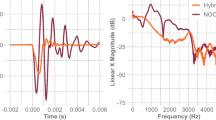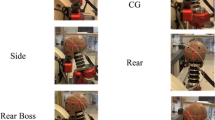Abstract
The design of modern hollow golf club heads is a labor-intensive process involving extensive performance festing both by robotic and real golfers. This paper describes how, by correlating club head mechanical behavior with functional performance, it will become possible to use validated computational models to predict this performance as well as related contributions to the ill-defined concept of “feel”. Successful use of experimental modal analysis to validate a hollow golf club head finite element model is reported. Modal tests employing noncontacting, laser-based transducers facilitated identification of the natural frequencies and corresponding modeshapes for the three main surfaces of the club head. The experimental data suggest predominantly different modal characteristics for each surface, and this compares favorably with equivalent data obtained from the finite element model. The modal data are also used to identify surfaces responsible for particular frequency components present in the club head impact sound spectrum. The potential for detailed impact performance prediction using the finite element model is further demonstrated by comparison of computed and experimental club head acceleration measurements recorded during simulated and actual club-ball impacts.
Similar content being viewed by others
References
Braham, J., “Super Clubs Hit the Sweet Spot,” Machine Des., 30–34 (April 1992).
Chou, P.C., Liang, D., and Yang, J., “Contact Forces, Coefficient of Restitution and Spin Rate of a Golf Ball Impact,” Science and Golf 2, Proc. World Scientific Congress of Golf, ed. A.J. Cochran and M.R. Farrally, St. Andrews, 296–301 (1994).
Iwata, M., Okuto, N., and Satoh, F., “Designing of Golf Club Heads by Finite Element Method (FEM) Analysis,” Science and Golf, Proc. First World Scientific Congress of Golf, ed. A.J. Cochran, St. Andrews, 274–279 (1990).
Stead, A., “Analysis of the Impact Stresses on a Metal Golf Wood Using Finite Element Methods,”BEng project report, Department of Manufacturing Engineering, Loughborough University, Leichestershire, UK (1992).
Thomson, R.D., Whittaker, A.R., Wong, K., and Adam, A., “Impact of a Golf Ball with a Rigid Clubface,” Proc. 6th UKABAQUS User Group Conference, September 27, 1990, ed. S. Brundrett and J.G. Redhead, University of Manchester, 41–47 (1990).
Mather, J.S.B., “The Role of Club Response in the Design of Current Golf Clubs,”Proc. 14th Int. Modal Analysis Conf., Dearborn, MI, Vol. 1, 397–403 (1996).
Okubo, N. and Simada, M., “Application of CAE (Computer Aided Engineering) to Golf Club Dynamics,” Science and Golf, Proc. First World Scientific Congress of Golf, ed. A.J. Cochran, St. Andrews, 270–273 (1990).
Swider, P., Ferraris, G., andVincent, B., “Theoretical and Experimental Dynamic Behaviour of a Golf Club Made of Composite Material,”Modal Analysis: Int. J. Analytical and Experimental Modal Analysis,9,57–69 (1994).
Thomas, G., Deiters, T., andBest, C.,”Simulating Golf Club Performance Using Modal Analysis,”Proc. 13th Int. Modal Analysis Conf., Vol. 2, 989–995 (1995).
Varoto, P.S. and McConnell, K.G., “Using Modal Analysis to Evaluate Golf Club Performance,” Sound and Vibration, 20–23 (March 1995).
Hocknell, A., Jones, R., andRothberg, S.J., “Experimental Analysis of Impacts with Large Elastic Deformation. Part 1: Linear Motion,”Meas. Sci. Tech.,7 (9),1247–1254 (1996).
Hocknell, A., Jones, R., and Rothberg, S.J., “Engineering ‘Feel’ in the Design of Golf Clubs,” The Engineering of Sport: Proc. 1st Int. Conf. Engineering of Sport, ed. S.J. Haake, Sheffield, 333–337 (1996).
Mitchell, S.R., Newman, S.T., Hinde, C.J., and Jones, R., “A Design System for Iron Golf Clubs,” Science and Golf 2: Proc. World Scientific Congress of Golf, ed. A.J. Cochran and M.R. Farrally, St. Andrews, 390–395 (1994).
Mitchell, S.R., “A Feature Based Approach to the Computer Aided Design of Sculptured Products,”Ph.D. thesis, Loughborough University, Leichestershire, UK (1996).
Hocknell, A., Mitchell, S.R., Underwood, D.J., and Jones, R., “Feature Based Quadrilateral Mesh Generation for Sculptured Surface Products,” J. Des. Manufact.
Ewins, D.J., Modal Testing Theory and Practice, Research Studies Press (1984).
Jones, R. andWykes, C., Holographic and Speckle Interferometry, Cambridge University Press, Cambridge (1983).
Author information
Authors and Affiliations
Rights and permissions
About this article
Cite this article
Hocknell, A., Mitchell, S.R., Jones, R. et al. Hollow golf club head modal characteristics: Determination and impact applications. Experimental Mechanics 38, 140–146 (1998). https://doi.org/10.1007/BF02321657
Received:
Revised:
Issue Date:
DOI: https://doi.org/10.1007/BF02321657




